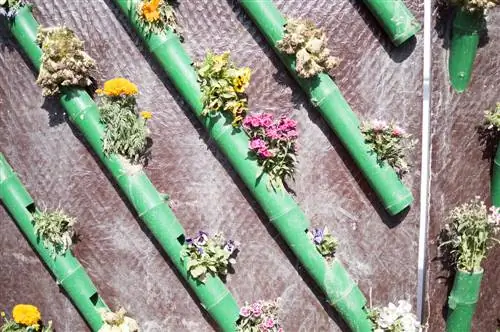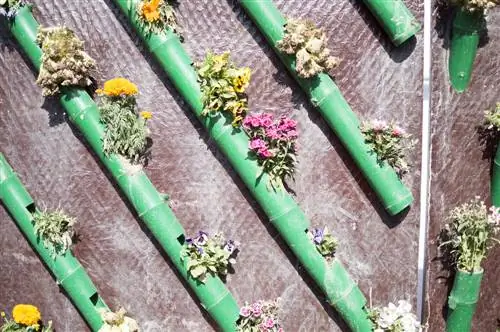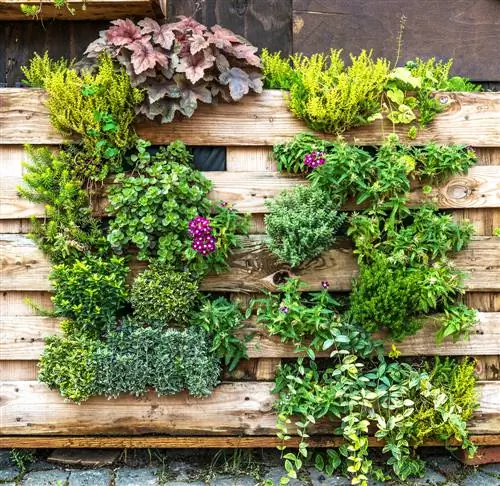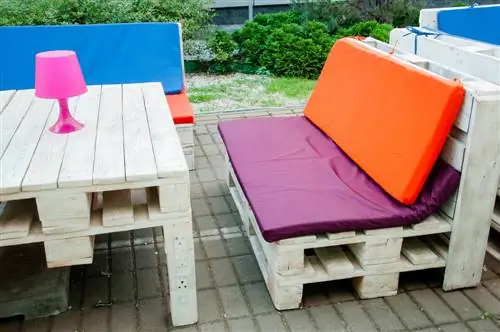- Author admin [email protected].
- Public 2024-01-05 20:48.
- Last modified 2025-01-23 11:21.
Vertical gardens save space and add greenery to boring walls. They are used both indoors and outdoors. Professional models have a sophisticated irrigation system, but unfortunately they are quite expensive and use a lot of water. It is cheaper if you build the vertical garden yourself. Below we explain three different options with different levels of difficulty.

How to build a vertical garden yourself?
To build a vertical garden yourself, you can make holes in PVC pipes, place plants planted in cans or jars on shelves, or use planted pallets. Succulents, ferns and climbing plants are particularly suitable for these gardens.
Which plants for the vertical garden?
If you want to have less work, you should choose plants for your vertical garden that need little water, such as succulents. However, these grow very slowly, so a densely overgrown green wall is unlikely to emerge. But if that's your goal, consider using larger plants that quickly cover gaps, such as ferns. Climbing plants are also ideal. Flowering perennials and herbs are often used outdoors, while spider plants and ferns are used indoors. It is also conceivable to have an edible vertical garden, e.g. B. to create with vegetables or fruit. Find out more here.
Ideas for alternative vertical gardens
A vertical garden doesn't have to cost a lot of money. Homemade solutions often look much more attractive. Here are a few suggestions on how you can easily make a vertical garden yourself:
- Cut holes in a long PVC tube, fill them with soil, place them vertically and place plants in the openings. (explained below)
- Stack flower pots of different sizes on top of each other to create a kind of staircase.
- Put plants in cans and jars and hang them on the wall.
- Cut PVC pipes lengthwise and plant. (explained below)
- Plant shoe rack.
- Plant plant bags or shoe bags.
- Place flower pots with hanging plants on ladder.
- Make a vertical garden from a Euro pallet. You can find the instructions here.
Vertical garden made of PVC pipe
In this guide we explain how to make a vertical garden out of a single PVC pipe by cutting openings in this pipe and planting them. The PVC pipe is placed vertically.
Tool and material list
- PVC pipe
- Flex
- Hot air dryer
- Earth
- Plants
- Meter measure
- Edding for marking
- glass bottle
Measuring
Depending on the length, you can make six or more incisions in your PVC pipe, which you will then plant. In a 0.5 meter long pipe you can cut a good six openings. Measure 15cm from the edge and mark this with a sharpie on both opposite sides of the pipe.
Cutting
Saw a strip about 10cm wide on both opposite sides at the marked point.
Heating and denting
Heat the area around the strip until you can bend the PVC. Then insert the glass bottle into the slot and bulge the PVC outwards. Repeat the process on the other side.
Next cuts
Then mark the next interface - not directly above the previous interfaces but between them so that the openings are offset. Repeat the process of heating and denting. Mark the last two 15cm higher - offset again - heat and dent.
Now fill your PVC tube with soil and place plants in the openings.
Tip
Instead of drilling, you can place the cans and jars (and also flower pots) on different wide shelves that you mount one above the other on the wall.






